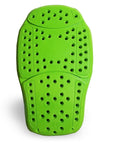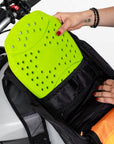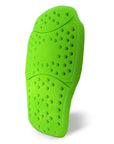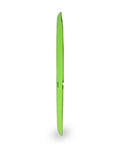Premium back protector that easily moulds to the shape of your back, but hardens on impact. Can fit in most Kevlar hoodies and leather jackets as an insert, or use in our Ashvault Backpack back protector compartment.
Specs
Size: 412mm x 242mm x 20mm
Suits Dainese leather and textile motorcycle jackets, Alpinestars leather and textile motorcycle jackets, most Kevlar hoodies and jackets - please email us to confirm if unsure.
Material
This armour is made of viscoelastic material.
Viscoelastic armour is soft and body-forming until it is impacted. At impact it reacts quickly to form a rigid mass. The material prevents trauma to the human body by three methods:
- Shock Absorption: Material absorbs impact energy through phase change (hardening).
- Shock Delay: Material delays the transmittance of some shock to the human body over a longer period of time.
- Dissipation: Impacts are dissipated over larger areas of the body.
Viscoelastic armour is able to achieve a higher level of shock/impact reducing benefits with more comfort and less bulk than traditional hard armour - foam laminate solutions. Hybrid armour is layered with hard shell outer materials.
Rating
European standard EN-1621 is used to rate the effectiveness of armour. In this standard, a 5 kg flat impactor impacts the armour at a speed of 4.47 m/s (energy 5x4,47x4,47/2=50 J "Joules"). 50 J of energy is roughly equivalent to dropping a 1 kg mass from a height of 5m (E=mGH). Sensors measure how much force is transmitted through the armour, its peak force in kilo-newtons (kN), and its period (how long it took the force to be transmitted). If the force transmitted through the armour is less than 35 kN then the armour (all armour except back) can attain an EN-1621-1 rating.[1] Standard also includes other factors such as temperature stability and coverage area. The back protection standard is EN-1621-2. That standard rating is based on that energy being less than 18 kN (EN-1621-2 Level 1) or less than 9 kN (EN-1621-2 Level 2).
(Quoted directly from Wikipedia)
European Standard EN 1621-2:2003[2] defines two levels of performance for CE approved back protectors.
The test apparatus and procedure is similar to that of EN 1621-1:1997,[1] but with a different impactor and anvil configuration. The impactor is a rounded triangular faced prism, of length 160 mm, base 50 mm, height 30.8 mm and radius 12.5 mm. The anvil is a radiused cylinder, with its axis orientated to the direction of impact, of height 190 mm, diameter 100 mm and rounded end radius 150 mm.
Testing Standards
When tested to the procedure defined in the standard, the two levels of performance are:
Level 1 protectors: The average peak force recorded below the anvil in the tests shall be below 18 kN, and no single value shall exceed 24 kN.
Level 2 protectors: The average peak force recorded below the anvil in the tests shall be below 9 kN, and no single value shall exceed 12 kN.
Back protectors are often not included in the standard complement of armour although many jackets allow a back protector to be installed.
Because of the more delicate nature of the spinal column, back protectors require that lower levels of force be transmitted.
The introduction to EN 1621-2 states that approximately 13% of motorcyclists injured in road accidents have an injury to this back region.
(Quoted directly from Wikipedia)







